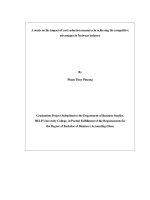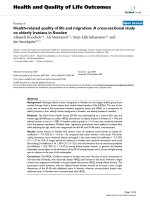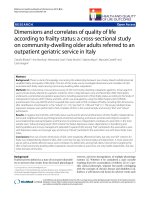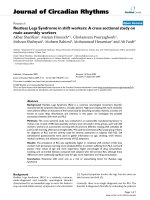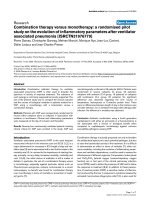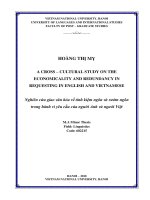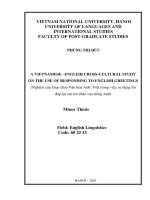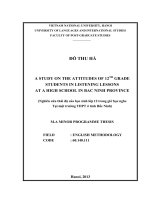A cross sectional study on the profile of drug resistant mutations in nucleos(t)ide analogue experienced chronic hepatitis b patients in tianjin
Bạn đang xem bản rút gọn của tài liệu. Xem và tải ngay bản đầy đủ của tài liệu tại đây (5.37 MB, 127 trang )
分 类 号:R195.1
学校代码:1 0 0 6 2
密
学
级:
学位类别: 科学学位□
√
专业学位
号:2015602941
学科门类:医学
硕 士 学 位 论 文
MASTER’S DISSERTATION
论文题目:天津地区慢性乙型肝炎病毒感染者核苷酸
类似物耐药位点突变横断面分析
TITLE
A cross-sectional study on the profile of drug-resistant
mutations in nucleos(t)ide analogue-experienced chronic
hepatitis B patients in Tianjin
一级学科:临床医学
二级学科:内科学
传染病学
论文作者:TRIEUCONGDOANH
指导教师:侯 伟 教授
天 津 医 科 大 学 研 究 生 院
二〇一八年五月
Edited by Foxit Reader
Copyright(C) by Foxit Corporation,2005-2009
For Evaluation Only.
学位论文原创性声明
本人郑重声明:所呈交的论文是我个人在导师指导下独立进行研究工作取
得的研究成果。除了文中特别加以标注引用的内容和致谢的地方外,论文中不
包含任何其他个人或集体已经发表或撰写过的研究成果,与我一同工作的同志
对本研究所做的任何贡献均已在论文中作了明确的说明并表示了谢意。
学位论文作者签名:
日期:
年
月
日
学位论文版权使用授权书
本学位论文作者完全了解天津医科大学有关保留、使用学位论文的规定,
即:学校有权将学位论文的全部或部分内容编入有关数据库进行检索,并采用
影印、缩印或扫描等复制手段保存、汇编以供查阅和借阅。同意学校向国家有
关部门或机构送交论文,并编入有关数据库。
保密
,在
年解密后适用本授权书。
本论文属于
不保密
√。
(请在相对应的方框内打“√” )
学位论文作者签名:
导
师
签
名:
日期:
年
月
日
日期:
年
月
日
Tianjin Medical University
中文摘要
目的:乙型肝炎病毒(HBV)感染是全世界最严重和最普遍的健康问题之一。
HBV 感染呈世界性流行,但不同地区 HBV 感染的流行强度差异很大。据世界卫
生组织( WHO)报道,全球约 20 亿人曾感染 HBV,其中 2.4 亿人为慢性 HBV 感
染者,每年约有 65 万人死于 HBV 感染所致的肝功能衰竭、肝硬化(LC)和肝
细胞癌(HCC)。HBV 属嗜肝 DNA 病毒科( hepadnaviridae),基因组长约 3.2
kb,为部分双链环状 DNA, 含有多个开放阅读框(ORF),其基因组编码 HBsAg、
HBeAg、HBcAg、病毒 DNA 多聚酶和 HBx 蛋白。P 区编码DNA聚合酶,此
酶既具有反转录酶活性,又有催化合成 DNA 的多聚酶功能。P 区包括四个编码区
域,其中逆转录酶区(RT 区)包含五个功能保守区域:A 区、B 区、C 区、D
区、E 区,其中 A、C、D 区为酶与三磷酸核苷结合的区域,B、E 区为 RNA 模
板和引物定位域。HBV 至少有 A-J 这几个基因型,我国以 B 型和 C 型为主。
目前使用核苷(酸)类似物(NAs)对乙型肝炎病毒(HBV)感染者行直接抗病毒
药物治疗。口服药物方面,在拉米夫定(LAM)、阿德福韦酯(ADV) 、恩替卡韦
(ETV)、替比夫定(LDT) 、替诺福韦酯(TDF)的基础上,新增替诺福韦艾拉酚胺
富马酸(TAF)这一新药。NAs 其进入机体后,形成三磷酸活性成分与机体天然的
脱氧三磷酸核苷(dNTP) 竞争结合到 HBV 聚合酶上,使 HBV 的 DNA 链合
成终止,这是核苷(酸)类似物抑制 HBV 复制的机制。NAs 使用核苷(酸)类似
物能导致在 HBV 聚合酶逆转录酶(RT)结构域位点的保守区发生突变。HBV 常见的
耐药突变位点多位于 HBV 逆转录酶区的 B、C、D 结构域内。不同抗病毒药物
所致的耐药突变位点不同:如①拉米夫定(LAM)耐药:在 HBV 基因组中反转录
酶区的 C 结构域内有一个高度保守的 YMDD 基序,即酪氨酸-甲硫氨酸-天门冬
氨酸-天门冬氨酸。拉米夫定能够与其特异性结合,通过抑制前基因组 RNA 反转
录为负链 DNA 并终止 DNA 链延伸而有效抑制 HBV DNA 复制。②阿德福韦酯
(ADV)耐药:阿德福韦酯同样也能抑制逆转录酶活性,但其耐药突变概率比拉米
夫定低,阿德福韦酯耐药与逆转录酶 B 区或 D 区位点有关,从而降低阿德福韦
酯对 HBV DNA 的抑制作用。③恩替卡韦(ETV)具有高耐药基因屏障,至少需要
三个位点发生突变才可构成耐药。在接受抗病毒药物治疗的患者体内,HBV 突
变株和野生株的比例不断发生变化,而这种变化反过来会影响核苷酸类药物的抗
I
Tianjin Medical University
病毒疗效,进而发生基因型耐药(genotypic resistance)、表型耐药(phenotypic
resistance)及临床耐药。检测到与 NAs 相关的 HBV 耐药基因突变,称为基因型
耐药(genotypic resistance)。体外实验结果显示抗病毒药物敏感性降低,且与基
因型耐药相关,称为表型耐药(phenotypic resistance)。针对一种抗病毒药物出
现的耐药突变对另一种或几种抗病毒药物也出现耐药,称为交叉耐药(cross
resistance )。 至 少 对 两 种 不 同 类 别 的 NAs 耐 药 , 称 为 多 药 耐 药 ( multidrug
resistance)。耐药变异的产生一方面是在分子结构上产生了影响 HBV 聚合酶表达
的基因变异; 另一方面耐药变异株和野生株的共生生态的变化, 耐药变异株要
能够持续的复制增殖达到一定的数量水平成为所谓的优势株,并表现出耐药的临
床表现。HBV 逆转录酶区耐药基因变异的检测方法:运用 DNA 测序原理的检测
方法如(1)直接测序法,该方法对 HBV 全基因组测序,既可对已知的耐药变异位
点进行检测,也可对未知的耐药变异进行检测研究。临床上以检测常见耐药变异
位点为主。在直接测序基础上发展克隆测序法。(2) 焦磷酸测序法,该方法的检
测通量高,可以对 HBV 基因组上的任意片段进行测序,在同时检测多个已知的
耐药变异同时也可以检测未知的耐药变异。不需要标记引物、核苷酸和凝胶电泳,
具有高灵敏、高特异性和准确性等特点,能早期检测核苷(酸)类似物治疗患者
的 HBV 逆转录酶区基因耐药突变异。还可以运用杂交原理的检测方法如(1)线
性探针技术,将特异的寡核苷酸探针固定于硝酸纤维素膜条上对生物素化 PCR
扩增的目标片段进行反向杂交后显色,使检测结果肉眼可见。本法对检测样本病
毒载量的要求与直接测序法相近,可用于临床上早期发现耐药变异的出现。但本
方法受探针的局限,只能检测常见的几种变异位点,不能用于检测和研究未知的
耐药变异。(2)荧光实时定量 PCR, 该方法结合了 PCR 技术和 FRET 核酸定量
检测技术。在 DNA 扩增的同时释放可供检测的荧光信号,实现对模板 DNA 的
定量分析。该方法应用于单核苷酸多态性分析,检测的敏感性高,对血清样本病
毒载量要求较低。此法敏感性较高,可同时检测多个耐药变异位点。但本方法只
能检测常见的几种变异位点,不能用于检测和研究未知的耐药变异。(3) 基因芯
片法,该方法在芯片表面有序地固定高密度的寡核苷酸或特定基因片段探针,再
与生物素标记的待检基因片段反应, 然后通过显色产生荧光信号, 软件处理信
号获得待测基因序列信息。表型耐药检测是指在体外细胞培养系统中使 HBV 基
因组中一个或多个位点突变,再检测病毒对药物的敏感性降低或丧失,可作为耐
II
Tianjin Medical University
药诊断的依据。已发展多种技术如瞬时转染细胞模型、稳定转染细胞模型、酶活
性分析等用于检测表型耐药。目前使用核苷(酸)类似物耐药突变的特点与乙型肝
炎的治疗和管理密切相关。NAs 不能完全清除体内病毒,目前用药患者数巨大
且患者长期服用 NAs,对 NAs 耐药问题在临床上越发严重,往往导致患者病情
反复甚至加重。不同 NAs 药物导致慢性乙肝患者 HBV 逆转录酶区变异位点、
变异模式特点不同。本研究旨在探讨中国天津地区慢性乙型肝炎患者的突变位点
和突变模式的分布特点。
方法:本研究分为三部分。第一部分:对 1320 例慢性乙型肝炎患者 HBV 基因组
RT 区扩增,直接测序后分析耐药突变相关的位点,其中包括 rt80,rt169,rt173,
rt180,rt181,rt184,rt194,rt196 ,rt202,rt204,rt207,rt213,rt214,rt215,
rt236,rt237,rt238 和 rt250。然后分析其基因型、性别、年龄等是否存在统计学
显着性差异。在第二部分中,我们进一步研究各个突变位点的突变百分比以了解
抗病毒耐药的分子机制,包括 LAM,ADV,ETV,LDT 和 TDF。第三部分,我
们又进一步分析了基因型,性别和年龄组之间的突变模式。
结果:收集 2012 年 7 月至 2015 年 12 月在天津市第二人民医院,天津市肝病研
究所诊治的慢性乙型肝炎感染者 1320 名,其中男性占比 73.79%,女性占比
26.21%,患者的平均年龄为 46.94(10-80 岁),经分析发现其携带 HBV 的基因
型包括基因型 B 和基因型 C 两种,感染率分别为 8.71%和 91.29%,之后对耐药
相关突变位于 HBV P 基因的 RT 区域进行测序分析。
以 1320 例天津地区慢性乙型肝炎患者为研究对象,对所有患者的临床资料
进行突变分析,包括 rt80,rt169,rt173,rt180,rt181,rt184,rt194,rt196,rt202,
rt204,rt207,rt213,rt214,rt215,rt236,rt237,rt238 和 rt250,其中以 rtM204
突变率最多,占 24.25%,其次为 rt180(14.97%)和 rt181(12.43%)。之后,
我们进一步分析了不同 HBV 基因型、性别和年龄在各个位点突变所占的比例。
rtA181 位点 ADV 相关突变在基因型 C 中的百分比显着高于基因型 B(13.11%
比 4.25%,p <0.001),其他突变位(rtS213 p = 0.005,rtN236 p <0.001, rtV214
p <0.001 和 rtI233 p = 0.044)。与基因型 C 相关的 LAM 相关突变位点 rtV173 突
变率高于基因型 B(3.1%vs.0.47%,p = 0.019)。然而,rtM204 和 rtL180 的 LAM
III
Tianjin Medical University
相关突变和 rtT184,rtS202 和 rtM250 的 ETV 相关突变在基因型 B 和 C 之间无
显着差异(P> 0.05)。在性别分层亚组分析中,rtV207 位点的 LAM 相关突变在女
性中的表现比男性高(p = 0.002)
,在 rtI169 位点的 ETV 相关突变也是如此(p =
0.04)。然而,男性 rtS202 位点突变的突变比例高于女性(p = 0.003)。其余位点
未观察到男性和女性突变率的差异。在按年龄分层的亚组分析中,在 rtL80 和
rtT184 中发现显着差异,
(p <0.001),其他位点(rtV214 p = 0.024,rtN236 p = 0.001,
rtQ215 p = 0.005 和 rtP237 p = 0.007)。
我们进一步研究了突变位点所占百分比以了解抗病毒耐药的分子机制,包括
LAM,ADV,ETV,LDT 和 TDF 耐药。确定了总共 60 个耐药性突变位点。突
变位点以 rtM204I 最高,占 32.35%,其次为 rtL180M 和 rtM204V,分别占比 31.06%
和 18.03%。
(1)我们发现了 16 个相关耐药突变位点,即 rtL80I,rtL80V,rtV173L,rtV173M,
rtL180M,rtL180F,rtL180Q,rtM204V,rtM204I,rtM204K,rtM204L,rtM204Q,
rtM204S,rtV207I,rtV207L 和 rtV207M,其中以 rtL180M 最为常见,占 26.34%,
其次为 rtM204I,rtL80I 和 rtM204V,占比分别为 24.26%,16.33%和 12.73%。
此外,耐药性位点的分布在基因型、性别、年龄等方面亦存在差异。在基因型 B
中的比例明显高于基因型 C 的突变位点包括 rtV207M(5.32%vs1.04%p = 0.006)、
rtL80V(6.38%vs2.08%p = 0.021)。其他与 LAM 相关的突变位点在基因型 B 和基
因型 C 之间没有显着差异(p> 0.05)。当按性别分层时,突变位点 rtV207I 在女
性中的比例显着高于男性(11.46%vs7.06%,p = 0.017)。突变位点 rtV207L 显
示男性比女性低得多(0.96%vs2.87%,p = 0.025)。在性别分层分析中,除 rtV207I
和 rtV207L 外,其余位点突变无显着性别差异。在按年龄分层的亚组分析中,我
们在突变位点 rtL180M,rtM204V,rtV207I,rtV173L 和 rtL180V 中检测到显着
的差异比例(所有 p <0.05)。其他与 LAM 相关的耐药突变位点在年龄方面没有差
异。
(2)对于 ADV 相关耐药突变,检测到的突变位点,即 rtA181T,rtA181C,
rtA181G,rtA181S,rtA181D,rtA181P,rtA181H,rtS213T,rtS213N,rtV214A,
rtV214E,rtV214I,rtV214P,rtV214T,rtQ215H, rtN236L,rtI233V,rtI233L,
IV
Tianjin Medical University
rtN236T,rtN236H,rtP237H,rtP237T,rtP237S,rtN / H238A,rtN / H238K,rtN
/ H238D,rtN / H238S,rtN / H238T,rtN / H238G 和 rtN / H238Q,其中 rtA181T
占 20.85%,其次为 rtS213T,rtV214A 和 rtA181V,分别占 16.17%,15.1%和
10.26%。基因 B 型患者 S213T 突变的患病率高于携带基因型 C 的患者(32.84%
vs.15.01%,p <0.001),Q215H(14.93%vs. 5.28%,p = 0.004)和 rtP237T (2.99%
vs.0.1%,p = 0.012)。rtN / H238R 位点突变在基因型 B 显著低于基因型 C(0.1%
vs. 10.45%,p <0.001),而突变位点 rtA181V 在基因型 C 中的比例显着高于基因
型 B(10.77%vs2.99 %,p = 0.038)。其他 ADV 相关的突变位点,基因型之间没
有发现显着差异。当按年龄分层时,在突变位点 rtS213T(p = 0.033),rtN236T
(0.001),rtQ215H(p = 0.02)和 rtP237(p = 0.038)中检测到显着的差异。其
它位点突变在年龄方面并没有显著差异。
(3)对于 ETV 相关耐药突变,检测到的
突变位点:rtI169T,rtI169M,rtI169L,rtI169V,rtL180M,rtT184S,rtT184A,
rtT184I,rtT184L,rtT184F,rtS202I,rtS202G,rtS202G, rtS202C,rtS202N,
rtM204V,rtM250I,rtM250L,rtM250R,rtM250V。其中,rtL180M 和 rtM204V
占 24.04%,其次为 rtS202G,rtT184I 和 rtT184L,分别为 11.28%,10.39%和 8.31%。
突变位点 rtI169I 在女性中的表达显着高于男性(6.25%vs0.35%,p = 0.01),
突变位点 rtI169L 也是如此(8.33%vs1.73%,p = 0.027)。男性和女性之间在其
他突变位点之间没有差异。在按年龄分层的亚组分析中,突变位点 rtL180M,
rtM204V 和 rtT184I 在年龄上有显着差异(p <0.05),其他突变位点未发现显著
差异。在基因型 B 和基因型 C 之间的 ETV 相关突变位点亦未发现显着差异。
(4) 在 LDT 和 TDF 关系突变位点中,我们仅检测到 LDT 的一个突变位点:
rtM204V 和 TDF 的三个突变位点,即 rtA194T,rtA194I 和 rtA194V(表 9 和表
10)。 TDF 相关突变位点中,rtA194T 最常见,占比 80%。在基因型,性别和
年龄之间未发现显着差异。
除了突变位点的不同表现之外,我们进一步分析了基因型,性别和年龄组之
间的突变模式。基于 1320 例 CHB 患者,确定了 331 个突变模式。其中,ADV
相关突变模式 rtS213T 最常见,占 8.33%,其次是 rtA181T,rtV214A,分别占
6.67%和 5.91%。按照性别进行分层分析,采用卡方检验,观察到 ADV 相关模
式 rtA181T 在男性和女性之间的分布存在显着差异,男性比例显着高于女性(7.7%
V
Tianjin Medical University
vs3.76%,p = 0.012) 。然而,突变位点 ADV 相关 rtV214A 突变率女性比男性
高(8.67%vs.4.93%,P = 0.016),LAM 相关突变 rtV207I(5.49%vs.2.77%,p=
0.025 )
(图 5)。如图所示,LAM 相关突变 rtL80I 、 rtM204I 表现出 B 基因型
明显高于基因型 C(10.43%vs4.81%P = 0.016),以及与其他 ADV 相关突变
rtS213T + rtQ215H
(2.61%vs. 0.5%,p = 0.037)。ADV 基因型的突变模式 rtS213T
在基因型 C 中低于基因型 B
(7.8%比 13.91%,p = 0.033),rtN236T 也是如此(0.91%
比 4.35%,p = 0.009)。LAM 相关突变 rtV207L 和 rtV207M 在 B 基因型患者比
基因型 C 的患者更显着(2.61%vs0.58%,P = 0.049)、
(4.35%vs 0.25%,P <0.001)。
但 ADV rtA181T 基因型突变的比例 C 基因型高于基因型 B(7.14%vs.1.74%,P =
0.029)。其余在 B 型和基因型 C 之间发现无显着差异,在年龄分层的亚组分析,
突变模式 rtA181T,rtV214A,rtM204I,rtV207I,rtQ215H 和 rtL80I + rtM204I,
rtL80I + rtL180M + rtM204I 具有显著统计学差异(p <0.05)。
其次我们共发现 300 种组合模式,占所有 CHB 患者的 57.52%。分析发现
20 种最常见的组合突变模式分别为:rtL80I + rtM204I,rtL80I + rtL180M +
rtM204I,rtL180M + rtM204V,rtL180M + rtM204I,rtL180M + rtM204I,rtL180M
+ rtM204V + rtS202G,rtA181T + rtN236T,rtA181V + rtN236T, rtA181T +
rtA181V + rtN236T,rtV173L + rtL180M + rtM204V,rtA181T + rtA181V,rtL180M
+ rtM204I + rtP237H,rtS213T + rtQ215H,rtA181T + rtV214A,rtL180M + rtM204V
+ rtA181V,rtL180M + rtM204V + rtT184L,rtV207I + rtA181T,rtL180M +
rtM204V + rtM204I,rtV173L + rtM204I,rtV207I + rtV214A 和 rtA181T + rtV214A
+ rtN236T。在发生组合突变的患者中,以 rtL80I + rtM204I 组合模式最常见,占
5.3%,rtL80I + rtL180M + rtM204I,rtL180M + rtM204V 和 rtL180M + rtM204I
分别占 3.86%和 3.79%。突变组合的频率,rtL80I + rtL180M + rtM204I,rtL180M
+ rtM204V 和 rtL180M + rtM204I 显示无显着差异,rtL80I + rtM204I 和 rtS213T +
rtQ215H 的比例在基因型 C 发生率高于基因型 B。组合突变如 rtL180M + rtM204V
+ rtS202G 和 rtA181T + rtN236T 在基因型之间也没有差异。
结论: 中国天津地区慢性乙型肝炎患者存在多种突变位点和突变模式。对
于应用核苷(酸)类似物抗病毒治疗的患者,应该注重耐药临床管理,加强患者依
从性,提高患者对疾病的认识,避免随意停药、换药;加强对医务人员抗病毒治
VI
Tianjin Medical University
疗耐药预防和管理的教育,避免不规范治疗;治疗中应定期检测 HBV DNA 以
及时发现原发性无应答或病毒学突破,及时调整治疗策略,以降低耐药风险;应
长期监测治疗效果及耐药位点,及时发现耐药突变,尽早干预;初治选择强效且
具有高耐药基因屏障的抗病毒药物或联合应用不同种类的抗病毒药物、避免单药
序贯治疗也能够降低耐药的发生; 已经发生多重耐药突变的患者,应立即选用
恰当的挽救治疗,选择有效的抗病毒药物(无交叉耐药),可将诱导发生多药耐药
的风险降至最低。针对 HBV 感染人体的各个环节作用的多靶位抗病毒药物研究
开发是治疗多重耐药 HBV 感染的新途径。
关键词:乙型肝炎 耐药相关突变位点 突变模式 核苷类似物 基因型 性别
年龄
VII
Tianjin Medical University
ABSTRACT
Objective:
Hepatitis B virus (HBV) infection is one of the most serious and
common prevalence health problems throughout the world. Chronic HBV infection
can bring about chronic hepatitis B (CHB) and then progress to liver cirrhosis (LC);
moreover, it may eventually develop to hepatocellular carcinoma (HCC). The
characteristics of drug- mutant resistance in nucleot(s)ide analogs have a strong
association with treatment and management hepatitis B. Mutation site and mutation
patterns are more and more complicated and currently limited. The study targeted to
discover the profile of mutation site and mutation patterns in patients with chronic
hepatitis B (CHB) in Tianjin, China.
Methods:
This study was stratified into three parts. The first part, 1320 case patients
with chronic hepatitis B were amplifier of the RT region in the HBV genome and
18AA positions related to drug resistance mutations in the RT region, including rt80,
rt169, rt173, rt180, rt181, rt184, rt194, rt196, rt202, rt204, rt207, rt213, rt214, rt215,
rt236, rt237, rt238 and rt250 were analyzed according to sequencing results. And then
statistical analysis was used to investigate whether significant difference was detected
with dividing genotypes, gender and age. In the second part, we took a further step to
study the proportion of mutant sites to comprehend the mechanism of molecular in
antiviral resistance, including LAM, ADV, ETV, LDT and TDF. In the third part, we
farther analyzed the mutation patterns between genotype, gender and age groups.
Result: In the first part, the drug resistance was detected at eighteen positions,
including rt80, rt169, rt173, rt180, rt181, rt184, rt194, rt196, rt202, rt204, rt207, rt213,
rt214, rt215, rt236, rt237, rt238 and rt250. Position at rt204 was the most of
frequently occurred with the percentage of 24.25%, follow by rt180 with 14.97% and
rt181 with 12.43%. Genotype C isolates had higher rates of ADV-related mutation
rtA181 than genotype B (13.11% vs. 4.25%, p<0.001). The ADV – associated
mutation at position rtS213, rtN236, rtV214, and rtI233 showed a remarkable higher
percentage in genotype C than genotype B (p<0.05, all). The LAM- associated
mutation site rtV173 with genotype C had a much higher mutation proportion than
VIII
Tianjin Medical University
genotype B (3.1% vs.0.47%, p=0.019). When stratified with gender, LAM associated
mutation at position rtV207 ETV associated mutation at rtI169 displayed a bigger rate
in female than male. The mutation at position rtS202 in male had higher mutation
proportion than female (p=0.003). The significant differences were identified in rtL80
and rtT184 with all p<0.001, and so did others position (rtV214 p=0.024, rtN236
p=0.001, rtQ215 p=0.005 and rtP237 p=0.007) in terms of age.
In the second part, overall sixty resistant mutation sites were identified. Mutation site
rtM204I was the most common with the proportion 32.35%. Study the percentage of
mutant sites to comprehend the molecular mechanism of antiviral resistance, (1)
LAM associated drug resistance, we discovered 16 mutation sites, namely rtL80I,
rtL80V, rtV173L, rtV173M, rtL180M, rtL180F, rtL180Q, rtM204V, rtM204I,
rtM204K, rtM204L, rtM204Q, rtM204S, rtV207I, rtV207L and rtV207M. The
rtL180M was the most frequently occurred with the most frequently occurred with
26.34%. The mutation site rtV207M indicated an essential higher proportion in
genotype B than genotype C (5.32% vs.1.04% p=0.006). Genotype B isolates had
higher rates of mutation site rtL80V than genotype C (6.38% vs.2.08% p=0.021). The
noteworthy difference proportion was found in mutation site rtL180M, rtM204V,
rtV207I, rtV173L and rtL180V (p<0.05, all) in terms of age. (2) ADV- related
mutation resistance, thirsty two mutation sites was detected, namely rtA181T,
rtA181C, rtA181G, rtA181S, rtA181D, rtA181P, rtA181H, rtS213T, rtS213N,
rtV214A, rtV214E, rtV214I, rtV214P, rtV214T, rtQ215H, rtQ215R, rtI233V, rtI233L,
rtN236T, rtN236H, rtP237H, rtP237T, rtP237S, rtN/H238A, rtN/H238K, rtN/H238D,
rtN/H238S, rtN/H238T, rtN/H238G, rtN/H238Q and rtN/H238R. The mutation site
rtA181T was the most common with the percentage 20.85%. The mutation site
mutation S213T in patients with genotype B had a much higher prevalent than
patients carrying genotype C (32.84% vs.15.01%, p<0.001). The mutation site Q215H,
rtP237T and rtN/H238R indicated an essential higher proportion in genotype B than
genotype C (14.93% vs. 5.28%, p=0.004), (2.99% vs.0.1%, p=0.012) and (10.45%
vs.0.1%, p<0.001). The mutation site rtA181V demonstrated a remarkable higher
proportion in genotype C than genotype B (10.77% vs.2.99%, p=0.038). When
IX
Tianjin Medical University
stratified with age, the mutation site rtS213T, rtN236T rtQ215H and rtP237 showed a
significant divergence rate (p<0.05, all). (3) ETV associated drug resistance, nineteen
mutation was identified, including rtI169T, rtI169M, rtI169L, rtI169V, rtL180M,
rtT184S, rtT184A, rtT184I, rtT184L, rtT184F, rtS202I, rtS202G, rtS202C, rtS202N,
rtM204V, rtM250I, rtM250L, rtM250R, rtM250V. The mutation site rtL180M and
rtM204V were the most predominant prevalent with 24.04%. The mutation site
rtI169I and rtI169L exhibited a significant higher rate in female than male (6.25% vs.
0.35%, p=0.01) and (8.33% vs. 1.73%, p=0.027). The mutation site rtL180M,
rtM204V and rtT184I had a remark difference frequent in terms of age (p<0.05, all).
(4) LDT associated drug resistance, one mutation site M204I was detected. (5) TDF
associated drug resistance, three mutation sites was detected, including rtA194T,
rtA194I and rtA194V. The mutation site rtA194T was the most common with 80%.
Fifteen seldom mutation sites was found, LAM-associated resistant mutation, two
mutation sites were detected, including rtL180F, rtL180Q and ADV-related resistance
mutation, with eleven uncommon mutation site, containing rtA181C, rtA181D,
rtA181H, rtA181P, , rtS213N, rtV214T, rtQ215R, rtI233L, rtN/H238G, rtN/H238K
and rtN/H238R. With ETV association resistant mutation, seldom mutation site
rtM250R was discovered and rtA194I for TDF relation resistant mutation.
In the third part, three hundreds thirty one mutation patterns were identified. The
ADV –associated mutation pattern rtS213T was the most frequently occurred with
8.33%. The pattern rtA181T in ADV relation mutation were observed with significant
difference between male and female (7.7% vs.3.76%, p=0.012). The mutation ADVassociated pattern rtV214A generated an essential bigger rate in female than male (8.67%
vs.4.93%, p=0.016). The proportion of mutation site rtV207I in female was higher than
male (5.49% vs.2.77%, p=0.025). The mutation pattern rtL80I+rtM204I in LAM
association mutation exhibited a substantial bigger rate in genotype B than genotype
C (10.43% vs.4.81% p=0.016). The mutation patterns rtS213T showed a bigger rate
in genotype B than genotype C (13.91% vs.7.8%, p=0.033). The distribution in
mutation rtN236T was found with remarkable divergence between genotype B and
genotype C (4.35% vs.0.91%, p=0.009). The pattern rtV207L in patients with
X
Tianjin Medical University
genotype B had a higher percentage than patients carrying genotype C (2.61% vs.
0.58%, p=0.049). The proportion of mutation pattern rtS213T+rtQ215H in genotype
B was bigger in genotype C (2.61% vs. 0.5%, p=0.037). The pattern rtV207M had
much lower prevalent in genotype C than genotype B (0.25% vs. 4.35%, p<0.001).
The pattern rtA181T in genotype C had a significant proportion higher than genotype
B (7.14% vs.1.74%, p=0.029). The mutation pattern rtA181T, rtV214A, rtM204I,
rtV207I, rtQ215H and rtL80I+rtM204I, rtL80I+rtL180M+rtM204I were significant
differed between terms of age with p all <0.05. Three hundred and one combination
mutations were found with 57.52% of CHB patients.
The combined mutation
rtL80I+rtM204I was most frequently observed with 5.3%. Twenty the most common
combined
mutation
patterns
was
detected,
containing
rtL80I+rtM204I,rtL80I+rtL180M+rtM204I,rtL180M+rtM204V,rtL180M+rtM204I,rt
L180M+rtM204I,rtL180M+rtM204V+rtS202G,rtA181T+rtN236T,rtA181V+rtN236T
,rtA181T+rtA181V+rtN236T,rtV173L+rtL180M+rtM204V,rtA181T+rtA181V,rtL180
M+rtM204I+rtP237H,
rtS213T+rtQ215H,
rtA181T+rtV214A,
rtL180M+rtM204V+rtA181V,
rtL180M+rtM204V+rtT184L,rtV207I+rtA181T,rtL180M+rtM204V+rtM204I,rtV173
L+rtM204I, rtV207I+rtV214A, and rtA181T+rtV214A+rtN236T.The combined
mutations rtL80I+rtM204I and rtS213T + rtQ215H, which showed the higher
proportion in genotype B than genotype C (p<0.05, all).
Conclusions: The characteristic of NA-resistant HBV are complicated in CHB
patients in Tianjin, China, which provided molecular epidemiology data for clinical
management. Therefore, persistently monitor the resistance mutations of HBV play
essential role in for optimizing management strategy and preventing an outbreak of
drug resistance.
Keywords Hepatits B
analogues
Genotype
Mutation Site Mutation Patterns
Gender
Age
XI
Nucleos(t)ide
Tianjin Medical University
中 文 摘 要
本研究旨在探讨中国天津地区慢性乙型肝炎患者的突变位点和突变模式的分布
特点。方法:对 1320 例慢性乙型肝炎患者 HBV 基因组 RT 区扩增,直接测序后分
析耐药突变相关的位点。然后分析其基因型、性别、年龄等是否存在统计学显著
性差异。在第二部分中,我们进一步研究各个突变位点的突变百分比以了解抗病
毒耐药的分子机制,我们又进一步分析了基因型,性别和年龄组之间的突变模式。
结论: 中国天津地区慢性乙型肝炎患者存在多种突变位点和突变模式。对于应用
核苷(酸)类似物抗病毒治疗的患者,应该注重耐药临床管理,加强患者依从性,
提高患者对疾病的认识,避免随意停药、换药;加强对医务人员抗病毒治疗耐药
预防和管理的教育,避免不规范治疗;治疗中应定期检测 HBV DNA 以及时发
现原发性无应答或病毒学突破,及时调整治疗策略,以降低耐药风险;应长期监
测治疗效果及耐药位点,及时发现耐药突变,尽早干预;初治选择强效且具有高
耐药基因屏障的抗病毒药物或联合应用不同种类的抗病毒药物、避免单药序贯治
疗也能够降低耐药的发生; 已经发生多重耐药突变的患者,应立即选用恰当的
挽救治疗,选择有效的抗病毒药物(无交叉耐药),可将诱导发生多药耐药的风险
降至最低。针对 HBV 感染人体的各个环节作用的多靶位抗病毒药物研究开发是
治疗多重耐药 HBV 感染的新途径。
关键词: 耐药相关突变位点 突变模式 核苷类似物
XII
Tianjin Medical University
CONTENT
ABSTRACT .................................................................................................................. VIII
ABBREVIATIONS ............................................................................................................ 1
1. INTRODUCTION .......................................................................................................... 2
2. -MATERIALS AND METHODS ................................................................................. 16
2.1. Patients ................................................................................................................. 16
2.2. Laboratory assessment ........................................................................................... 16
2.2.1. HBV DNA extraction and amplification.
................................................. 16
2.2.2. HBV genotyping and antiviral resistant mutation detection.
...................... 17
2.3. Statistical Analysis. .......................................................................................... 17
3-RESULT ........................................................................................................................ 18
3.1. Clinical features of study patients .......................................................................... 18
3.2. Mutation sites subgroup analysis by genotype, gender and age ............................ 19
3.2.1. Mutation each sites subgroup analysis by genotype, gender and age ............. 19
3.2.2. Mutation sites subgroup analysis by genotype, gender and age with drugs .... 20
3.3. Mutation patterns subgroup analysis by genotype, gender and age ....................... 36
4. DISCUSSION ............................................................................................................... 57
5-CONCLUSION ............................................................................................................. 61
6-FUTURE OUTLOOK ................................................................................................... 62
REFERENCES ................................................................................................................. 64
XIII
Tianjin Medical University
PUBLICATION ................................................................................................................ 71
REVIEW ........................................................................................................................... 72
ACKNOWLEDGEMENTS............................................................................................ 110
RESUME .........................................................................................................................111
XIV
Tianjin Medical University
ABBREVIATIONS
HBV
Hepatitis B virus
HBsAg
Hepatitis B virus surface antigen
HCC
Hepatocellular carcinoma
HBeAg
Hepatitis B e antigen
CHB
Chronic hepatitis B
BCP
Basal core promoter
HIV
Human immunodeficiency virus
NAs
Nucleos(t)ide analogues
LAM
Lamivudine
ADV
Adefovir
ETV
Entecavir
LDT
Telbivudine
TDF
Tenofovir
RT
Reverse transcriptase
YMDD
Tyrosine-methionine-aspartate
DNA
Deoxyribonucleic acid
RNA
Ribonucleic acid
dNTPs
Deoxynucleotide triphosphates
IgM HBcAg
Immunoglobulin M antibody to the core antigen
HDV
Hepatitis D virus
ORF
Open reading frame
RNase H
Ribonuclease H
rcDNA
Relaxed circular DNA
cccDNA
Covalently closed circular DNA
mRNAs
Messenger RNAs
HB-ACLF
Hepatitis B-related acute-on-chronic liver failure
1
Tianjin Medical University
1. INTRODUCTION
Hepatitis B virus (HBV) infection is one of the most serious and common frequent
health problems all around the world and more than 350 million people who got
chronic carriers of HBV surface antigen (HBsAg) and 2 billion human have proof of
past or present infection with HBV [1]. One study from The Global Burden of Disease
estimated that 686,000 deaths was responsible for hepatitis B in 2013 with a 5.9 per
100,000 age-standardized death rates globally, of which 317,400 deaths from cirrhosis
of the liver secondary to hepatitis B and 300,000 deaths were attributed to liver
cancer
[2]
. The distribution of infection disease is related with a large spectrum of
clinical manifestations range from acute or fulminate hepatitis to vary of chronic
infection, namely asymptomatic carries, chronic hepatitis, cirrhosis and hepatocellular
carcinoma (HCC)[3,4] .
China was characteristic as an area with a high pandemic of hepatitis B virus
infection and once a nationwide HBV investigation indicated that hepatitis B surface
antigen
carrier percentage in general population was 9.8%
[5]
. According to survey
nationwide in 2006 exhibited that the proportion of HBsAg carrier was decreased to
less than 8.0% and the HBsAg rate among children with age < 5 years was only
1.0%. Based on the prevalence of HBsAg and HBV infection gained from the two
national sero-epidemiological surveys, the numbers of HBV-infected patients and
HBsAg carriers have downfall by an measured 80 million and 20 million, respectively,
from 1992 to 2006
[6]
. Up to now, hepatitis B is still a main disease that impacts
human health, often causing chronic poverty because persistence, high prevalence,
and difficult treatment.
HBV has an incomplete circular double-stranded DNA genome which is
fundamentally encapsidated as a pregenomic RNA which undergoes reverse
transcription after encapsidation. With 4%–8% divergence in the S gene or more than
8% genetic variability in the full-length nucleotide sequence, at least 10 HBV
genotypes (A to J) and their subtypes have been identified
[7,8]
. While genotype A is
predominant proportion in sub-Saharan Africa, Northern Europe and Western Africa,
2
Tianjin Medical University
genotype B and C are common in Asia and genotype D prevails in the Mediterranean
region, Africa, Europe, and India. Genotype E was frequent in West and Central
Africa previously and now might be sought in uncommon cases of immigrants or
tourists in Latin America, Turkey, Northern India and Europe and genotypes F to J are
less epidemic and usually have their own specific distributions
[9]
. Whereas HBV
Genotypes A-H is accepted genotypes and their demonstrations have been well
identified, genotypes I and J are tentative genotypes characteristic follow by their
genome divergences [10].
Table 1: HBV genotype–specific implications in patients with chronic hepatitis B
Genotype compare
Virological implications
B versus C
A versus D
B
C
A
D
Serum HBV DNA level
Lower
Higher
ND
ND
Frequency of precore A1896 mutation
Higher
Lower
Lower
Higher
Frequency of basal core promoter
Lower
Higher
Lower
Higher
Frequency of pre-S deletion mutation
Lower
Higher
ND
ND
Intracellular expression of HBV DNA
Lower
Higher
Lower
Higher
Secretion of HbeAg
Lower
Higher
ND
ND
Tendency of chronic infection
Higher
Lower
Lower
Lower
HBeAg seroconversion
Earlier
Later
Earlier
Later
HBsAg seroclearance
More
Less
More
Less
Histologic activity
Lower
Higher
Lower
Higher
A1762T/G1764A mutation
Immunologic implications
Clinical implications
3
Tianjin Medical University
Modes of transmission
Perinatal/vertical
Perinatal/vertical
Horizontal
Horizontal
Incidence of progression to cirrhosis
Lower
Higher
Lower
Higher
Higher
Lower
Higher
Lower
and hepatocellular carcinoma (HCC)
Response to interferon-based therapy
ND: not detected
In China, a difference genotype distribution was showed between North and
South; genotype C was more prevalent in northern China, while genotype B was
predominant in southern provinces [11]. And genotype D is more common in Xinjiang
Uygurs
[12]
. With different HBV genotypes also lead to the biological characteristics
and varying clinical of chronic hepatitis B (CHB) patients (Table 1). Acute infection
with genotypes B and C results in lower prevalent of chronic natural than genotypes A
and D. Compared to genotypes C and D, patients with genotype A and B cases have
higher percentage of spontaneous hepatitis B e antigen (HBeAg) seroconversion;
when this occurs, it may lead to delayed. There was a higher prevalent of basal core
promoter (BCP) A1762T/G1764A mutation, pre-S deletion in HBV genotype B and
genotype C had a lower viral load when compare with genotype C. Genotype D also
generate a higher rate of BCP A1762T/G1764A mutation than genotype A. These
demonstrations proposed essential pathogenic divergence in terms of HBV genotypes.
It may create more severe liver disease, containing cirrhosis and HCC in HBV
infection with genotypes C and D. Moreover, patients with genotype A and B have
better responses to interferon-based treatment than genotypes C and D, but these has
not much coherent divergences for direct HBV antivirals [9] .
The replication of HBV has a high proportion, with 1012 virions was produced per
day and a high mutational prevalent of approximately 10-5 substitutions/base/cycle
[13]
.
4
Tianjin Medical University
Figure 1: The replication cycle of HBV (a) with a focus on the steps of intra-capsid
reverse transcription (b)
This phenomenon leads to approximately from 1010- 1011 point mutations created per
day in individuals with active replication. The genome of HBV is only with
approximately 3,200 base pairs, so all ability single base changes can be altered per
day. Because HBV rt has not a proofreading function to fix incorrectly incorporated
nucleotides, point mutations can increase very rapidly as do A–G hyper-mutations.
Before treating, there is a different swarm of viruses quasi-species, including mutants
with single and double mutations possibly related with the resistance drug. The
mutation probability being identified during treatment is contingent on the ability
suppression of a drug to viral replication. Therefore, the low antiviral activity drug
cannot exercise potential chose pressure on the virus, and the drug resistant
opportunity is not high. Nevertheless, the replication of virus in suppression accepts
small chance for resistance to come out because mutagenesis is contingent on the
replication of viral genome. Nucleos(t)ide analogues (NAs) drug can inhibit viral
replication, but cannot eradicate the existence of virus or affect the intrahepatic
5
Tianjin Medical University
cccDNA reservoir in any major way. The consistent regimen of treatment should have
antiviral activities aimed to divert sites and lead to decline the risk of selecting out
drug-resistant species. The drug resistance appears by pressuring the appearance of
drug selection in replication occurs. Hence, if totally complete suppression of
replication could be achieved, resistance could not be an issue. Some elements
suggest to the existence of drug resistance, including genetic barriers to the expanding
of mutations, mechanism of drug resistance, viral replication space, and various host
factors contained in suppressing viral replication [14].
To date, five nucleos(t)ide analogues have been accepted in the therapy of chronic
hepatitis B (CHB), namely lamivudine (LAM), adefovir (ADV), entecavir (ETV),
telbivudine (LDT) and tenofovir (TDF) [1,3]. Drug NAs can suppress the replication of
HBV mainly by restraining pregenomic RNA in the reverse transcription into DNA.
The substitution amino acids in HBV reverse transcriptase (RT) will cause NAs
resistance, which is a tremendous challenge in the management of CHB. The
resistance in treating hepatitis B virus by nucleos(t)ide analogue therapy is
remarkable structure specific, within dividing to three kinds of structural groups. The
resistance in each of these is determined by specific mutations in the domains with
reverse transcriptase of the HBV polymerase. It may relate with compensatory
mutations which can cause replication. The HBV polymerase is reputed to have a
traditional conformation with ‘right-handed’ structure, and the resistance in each of
mutations is predicted to create a specific structural change of the polymerase,
consequently preventing in-corporation of NA into DNA replication. The resistant
selection appears at divergence proportion for each NA and affect by the high
mutational proportion of HBV and the capacity of the drug to inhibit viral replication.
Some mutations or combinations of mutations may be related with multidrug
resistance, limiting treatment options. In the other way with most of other viruses,
HBV resistance is confounded by the overlapping surface in gene, the major NA
mutation resistance also changing the surface proteins in most cases, essentially
altering virus neutralization and secretion, which may threat to world public health in
the future.
6
Tianjin Medical University
The resistance to nucleos(t)ide analogues
and cross-resistance is potentially
structure specific, and the five NAs were approved can be stratified under three
main kinds of structural groups ( Table ) 2: (1)
L –nucleoside analogues,
containing lamivudine , its 5-fluoro derivative 7 odeli-itabine and telbivudine , (2)
acyclic nucleoside phosphonates, generated by the dAMP analogues adefovir and
tenofovir , and (3) deoxyguanosine analogues in which the deoxyribose moiety is
changed by a cyclopentane sugar derivative, including entecavir
Table 2: Patterns and pathways of antiviral drug resistance in chronic hepatitis B in
the context of cross-resistance
Pathway
Aminoacid substitutions
LAM
ADV
ETV
LDT
TDF
in the rt domain
Wildtype
S
S
S
S
S
L-nucleoside (LMV/LDT)
M204I/V
R
S
I
R
S
Acyclic phosphonate (ADV)
N236T
S
R
S
S
I
Shared (LMV, LDT, ADV)
A181T/V
R
R
S
R
I
Double (ADV, TDF)
A181T/V+N236T
R
R
S
R
R
D-cyclopentane (ETV)
L180M+M204V/I
R
S
R
R
S
±I169 ±T184
±S202 ±M250
I = Intermediate sensitivity; R = resistant; S = sensitive. I, R, and S are based on cell
culture and clinical reponses. Modified from [14, 46].
(a) - Resistance to LMV and Other
L –Nucleosides
LAM is the first approved antiviral drug with the highest resistance rate and the
resistance with drug LAM appeared at a cumulative percentage from 14–24% per
year getting levels of over 70% by 5–6 years in treating monotherapy [15, 16]. Mutation
is the result which replacing of methionine in the motif tyrosine-methionine-aspartate
(YMDD) catalytic site by isoleucine or valine. The change from this replacing are
7
Tianjin Medical University
invented rtM204V/I, utilizing the genotype independence nomenclature system which
proposed previously
[17]
. The mutation rtM204I substitution in isolation has been
detected, but the rtM204V alter in the HBV DNA in those patients who failing LAM
therapy is identified in association with other changes, which are remarkably
compensatory; containing rtL80V/I, rtV173L and rtL180M
[18,19]
. These
compensatory replace typically result in the promoted replication of viral with setting
of the primary resistance. These compensatory changes in genotypes have showed
that they only grow replication and do not direct effect on antiviral drug resistance
[20]
.
Figure 2: Cumulative incidence of hepatitis B virus resistance in pivotal trials.
Adapted from EASL clinical practice guidelines. J Hepatol 2012;57:167–185
In the second group which substitutions affected L –nucleoside antiviral sensitivity
has been identified in the domain B and contained the rtA181T substitution and lead
to ADV resistance , with this way can create a multidrug-resistant marker
mutation in drug L-dT (β-
L -2
[21]
. The
′ -deoxy-thymidine) has the same resistance profile
to LAM, with the rtM204I substitution being the major codon change related with
drug failure [22].
8
Tianjin Medical University
(b) - Resistance to Acyclic Nucleoside Phosphonates
Resistance in ADV occurs slower than LAM, appearing at a cumulative annual
prevalent of approximately more than 25% over 4 years [16], though long-term (5-year)
studies in chronic hepatitis B indicated higher proportion
[23]
; when utilized ADV as
rescue treatment after LAM failure it is also more common in individuals
[24]
. The
changes in single nucleotide that bring about substitutions in rtN236T and/or
[24, 25]
rtA181V/T are sufficient to produce ADV clinical failure
.
Regarding to TDF resistance, to date, no typical TDF-resistant mutations have been
described, even antiviral therapy which treated after 6 years and linked to the
rtA194T substitution, but only in relation with changes that lead to LAM resistance
and typically in the setting of co-infection with HIV-1
[26]
. The results from recent
clinical studies offer that TDF is less influence in the creating of ADV resistance, but
no singular single substitution has been characteristic that might be unclear in
association to primary TDF resistance [27].
ETV resistance has been mainly indicated in patients who had previous LAM failure.
Sequencing in HBV isolates from these patients usually reveals mutations which
create additional substitution amino acid in relation with the classical rtL180M and
rtM204V LMV resistance changes [28]. These changes conclude at least one of rtI169T,
rtT184G, rtS202I, or rtM250V. The overall resistance percentage for ETV in naïve
patients is <1% at 5–6 years and lead to 1.2% after treating 5-6 years [16, 29].
( c ) - Resistance to More than One NA
Regarding to 8 codons had a relation with primary resistance drug (rtI169T, rtT184G,
rtL180M, rtA181T/V, rtS202I, rtM204V/I, rtN236LT, and rtM250V), only mutation
site rtA181T and combined mutation rtL180M+rtM204V with substitutions have been
definitely related with multidrug resistance.
(d) - Molecular Mechanisms of Resistance to NAs
9
